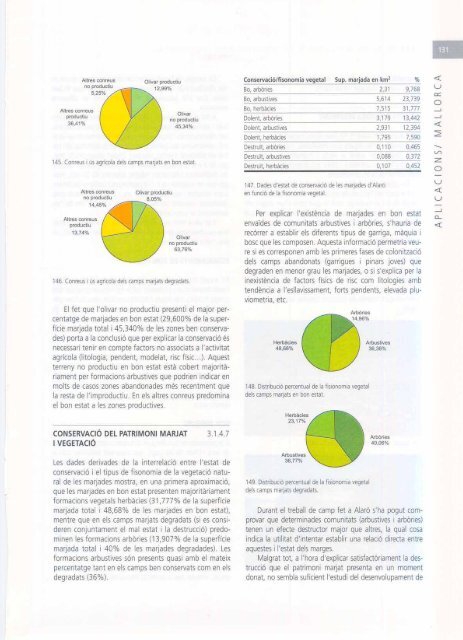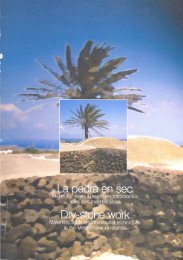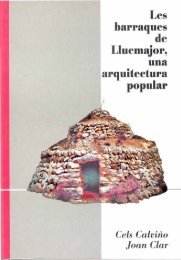Patrimoni de marjades a la mediterrània occidental: una proposta ...
Patrimoni de marjades a la mediterrània occidental: una proposta ...
Patrimoni de marjades a la mediterrània occidental: una proposta ...
Create successful ePaper yourself
Turn your PDF publications into a flip-book with our unique Google optimized e-Paper software.
Altres conreus<br />
productiu<br />
36,41%<br />
Altres conreus<br />
productiu<br />
13,74%<br />
Altres conreus<br />
no productiu<br />
14,45%<br />
Olivar productiu<br />
12,99%<br />
Olivar productiu<br />
8,05%<br />
Olivar<br />
no productiu<br />
45,34%<br />
Olivar<br />
no productiu<br />
63,76%<br />
EI fet que I'olivar no productiu presenti el major percentatge<br />
<strong>de</strong> marja<strong>de</strong>s en bon estat (29,600% <strong>de</strong> <strong>la</strong> superffcie<br />
marjada total i 45,340% <strong>de</strong> les zones ben conserva<strong>de</strong>s)<br />
porta a <strong>la</strong> conclusi6 que per explicar <strong>la</strong> conservaci6 es<br />
necessari tenir en compte factors no associats a I'activitat<br />
agrico<strong>la</strong> (Iitologia, pen<strong>de</strong>nt, mo<strong>de</strong><strong>la</strong>t, risc fisic. ..). Aquest<br />
terreny no productiu en bon estat esta cobert majoritariament<br />
per formacions arbustives que podrien indicar en<br />
molts <strong>de</strong> casos zones abandona<strong>de</strong>s mes recentment que<br />
<strong>la</strong> resta <strong>de</strong> I'improductiu. En els altres conreus predomina<br />
el bon estat a les zones productives.<br />
CONSERVACIO DEL PATRIMONI MARJAT<br />
I VEGETACIO<br />
Les da<strong>de</strong>s <strong>de</strong>riva<strong>de</strong>s <strong>de</strong> <strong>la</strong> interre<strong>la</strong>ci6 entre I'estat <strong>de</strong><br />
conservaci6 i el tipus <strong>de</strong> fisonomia <strong>de</strong> <strong>la</strong> vegetaci6 natural<br />
<strong>de</strong> les marja<strong>de</strong>s mostra, en <strong>una</strong> primera aproximaci6,<br />
que les marja<strong>de</strong>s en bon estat presenten majoritariament<br />
formacions vegetals herbacies (31,777% <strong>de</strong> <strong>la</strong> superffcie<br />
marjada total i 48,68% <strong>de</strong> les marja<strong>de</strong>s en bon estat),<br />
mentre que en els camps marjats <strong>de</strong>gradats (si es consi<strong>de</strong>ren<br />
conjuntament el mal estat i <strong>la</strong> <strong>de</strong>strucci6) predominen<br />
les formacions arb6ries (13,907% <strong>de</strong> <strong>la</strong> superfrcie<br />
marjada total i 40% <strong>de</strong> les marja<strong>de</strong>s <strong>de</strong>grada<strong>de</strong>s). Les<br />
formacions arbustives s6n presents quasi amb el mateix<br />
percentatge tant en els camps ben conservats com en els<br />
<strong>de</strong>gradats (36%).<br />
(onservaci6/fisonomia vegetal<br />
Bo, arbories<br />
Bo, arbustives<br />
Bo, herbacies<br />
Dolent, arbories<br />
Dolent, arbustives<br />
Dolent, herbacies<br />
Destrult, arbories<br />
Destrult, arbustives<br />
Destru'it, herbacies<br />
Sup. marjada en km 2<br />
147. Da<strong>de</strong>s d'estat <strong>de</strong> conservaci6 <strong>de</strong> les marja<strong>de</strong>s d'A<strong>la</strong>r6<br />
en funci6 <strong>de</strong> <strong>la</strong> fisonomia vegetal.<br />
2,31<br />
5,614<br />
7,515<br />
3,179<br />
2,931<br />
1,795<br />
0,110<br />
0,088<br />
0,107<br />
9,768<br />
23,739<br />
31,777<br />
13,442<br />
12,394<br />
7,590<br />
0,465<br />
0,372<br />
0,452<br />
Per explicar I'existencia <strong>de</strong> marja<strong>de</strong>s en bon estat<br />
enval<strong>de</strong>s <strong>de</strong> comunitats arbustives i arb6ries, s'hauria <strong>de</strong><br />
rec6rrer a establir els diferents tipus <strong>de</strong> garriga, maquia i<br />
bosc que les composen. Aquesta informaci6 permetria veure<br />
si es corresponen amb les primeres fases <strong>de</strong> colonitzaci6<br />
<strong>de</strong>ls camps abandonats (garrigues i pinars joves) que<br />
<strong>de</strong>gra<strong>de</strong>n en menor grau les marja<strong>de</strong>s, 0 si s'explica per <strong>la</strong><br />
inexistencia <strong>de</strong> factors frsics <strong>de</strong> risc com litologies amb<br />
ten<strong>de</strong>ncia a I'esl<strong>la</strong>vissament, forts pen<strong>de</strong>nts, elevada pluviometria,<br />
etc.<br />
148 Distribuci6 percentual <strong>de</strong> <strong>la</strong> fisionomia vegetal<br />
<strong>de</strong>ls camps marjats en bon estat.<br />
149. Distribuci6 percentual <strong>de</strong> <strong>la</strong> fisionomia vegetal<br />
<strong>de</strong>ls camps marjats <strong>de</strong>gradats.<br />
Durant el treball <strong>de</strong> camp fet a A<strong>la</strong>r6 s'ha pogut comprovar<br />
que <strong>de</strong>termina<strong>de</strong>s comunitats (arbustives i arb6ries)<br />
tenen un efecte <strong>de</strong>structor major que altres, <strong>la</strong> qual cosa<br />
indica <strong>la</strong> utilitat d'intentar establir <strong>una</strong> re<strong>la</strong>ci6 directa entre<br />
aquestes i I'estat <strong>de</strong>ls marges.<br />
Malgrat tot, a I'hora d'explicar satisfact6riament <strong>la</strong> <strong>de</strong>strucci6<br />
que el patrimoni marjat presenta en un moment<br />
donat, no semb<strong>la</strong> suficient I'estudi <strong>de</strong>l <strong>de</strong>senvolupament <strong>de</strong><br />
-




